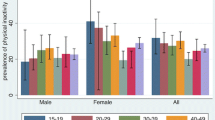Abstract
Title
Increasing recreational and leisure time physical activity in Poland–how to overcome barriers of inactivity
Aim
International experts have alerted us about the burden of a sedentary lifestyle. In recent WHO reports, lack of physical activity was placed as one of the leading risk factors of chronic diseases affecting both developed and developing countries. Despite some beneficial changes in lifestyle during the last decade, the level of physical activity in Poland still differs from many other European countries and international recommendations as well.
Methods
The analysis was based on a review of the Medline database, the main Polish governmental documents and studies concerning physical activity levels and the most interesting recent programmes on the topic.
Results
In the article the physical activity level of the Polish population and the main factors influencing it are discussed. The results of the national WOBASZ Project (2003–2005) revealed that nearly 35% of Polish adults are not active during their leisure time, while only about 17% are only occasionally engaged in any exercise. Over 42% of children up to 14 years old spend above 3 h per day in front of a TV or computer monitor. Over 50% of Polish teenagers aged 15–19 years do not participate in any kind of recreational physical activity. The most successful or promising programmes promoting active lifestyles recently applied in Poland are described in the article. The Great Polish Nationwide Physical Activity Campaign “Revitalize Your Heart” as an innovative and effective complex method is discussed by the authors.
Conclusions
Promising results from several new innovative large-scale physical activity-promoting programmes developed and implemented in Poland in last 5 years let us hope that the battle against a sedentary lifestyle and its health consequences could result in further progressive improvement of the physical activity level of the whole society.


Similar content being viewed by others
References
Barengo NC, Kastarinen M, Lakka T, Nissinen A, Tuomilehto J (2006) Different forms of physical activity and cardiovascular risk among 24–65-year-old men and women in Finland. Eur J Cardiovasc Prev Rehabil 13:51–59
Bauman A, Lewicka M, Schoppe S (2005) Review of best practice in interventions to promote physical activity in developing countries. Center for Physical Activity and Health, School of Public Health, University of Sydney, Australia for WHO Workshop on Physical Activity and Public Health. Beijing, China, 24–27 October 2005
Drygas W, Kostka T, Jegier A, Kuński, H (2000) Long-term effects of different physical activity levels on coronary heart disease risk factors in middle-aged men. Int J Sports Med 21(4):235–241
Drygas W, Skiba A, Bielecki W, Puska P (2001) Physical activity estimation among the inhabitants of six European countries Project “Filling the Reducing East-West Health Gap”. Med Sport 5(2):119–125 [in Polish]
Drygas W, Ruszkowska J, Mianowany M (2002) How to organize the Great Polish Nationwide Physical Activity Campaign. Fundacja Wszystko dla Zdrowia, Łódź. (in Polish)
Drygas W, Kwaśniewska M, Szcześniewska D, Kozakiewicz K, Głuszek J, Wiercińska E, Wyrzykowski B, Kurjata P (2005) Assessment of physical activity level in Polish adults. The results from the WOBASZ Project. Pol Popul Rev 27:76–82
European Guidelines on CVD Prevention in Clinical Practice (2003) Eur Heart J 24(17):1601–1610
Kaleta D, Jegier A (2005a) Occupational energy expenditure and leisure-time physical activity. Int J Occ Med Envir Health 18(4):351–356, DOI 10.2478/v10001-007-0019-z
Kaleta D, Jegier A (2005b) Characteristic of physical activity among adults in urban population of Poland. Przegl Lek 62(Suppl):14–17
Kaleta D, Jegier A (2007) Predictors of inactivity in the working–age population. Int J Occ Med Envir Health 20(1):175–182
Laaksonen M, McAlister AL, Laatikainen T, Drygas W, Morava E, Nussel E, Oganov R, Pardell H, Uhanov M, Puska P (2001) Do health behaviour and psychosocial risk factors explain the European East-West gap in health status? Eur J Public Health 11:65–73, DOI 10.1093/eurpub/11.1.65
Łata E (2006) Exercising a new diet direction. European Union issue 13:1–3
Martin SB, Morrow JR Jr, Jackson AW, Dunn AL (2000) Variables related to meeting the CDC/ACSM physical activity guidelines. Med Sci Sports Exerc 32:2087–2092
MMWR (2005) Adult participation in recommended levels of physical activity-United States, 2001 and 2003; MMWR 2005; 54:1208–1212
Polish Central Statistical Office (2006) Report: health condition of Polish society in 2004
Ruszkowska-Majzel J, Drygas W (2005) Great nationwide physical activity campaign “revitalize your heart” as an effective method of promoting active lifestyle in Poland. Przegląd Lekarski 62(supl 3):23–26 (in Polish)
Ruszkowska-Majzel J, Kwaœniewska M, Bednarek-Gejo A, Drygas W (2005) Evaluation of the great nationwide physical activity campaign in Poland: the “revitalize your heart” experience. Medicina Sportiva 9(4):117–122
Varo JJ, Martinez-Gonzalez MA, Irala-Estevez J, Kearney J, Gibney M, Martinez JA (2003) Distribution and determinants of sedentary lifestyles in the European Union. Int J Epidemiol 32:138–146. DOI 10.1093/ije/dygo18
World Health Organization (2002) The world health report 2002: reducing risks, promoting healthy life
World Health Organization (2003) Diet, nutrition and the prevention of chronic diseases. WHO Technical Report Series 916
Zdrojewski T, Bandosz P, Szpakowski P (2004) Prevalence of main risk factors for cardiovascular diseases in Poland. Results from the NATPOL PLUS Project. Polish Heart J 61:4–5
Acknowledgement
Conflict of interest statement
The authors guarantee that the article “Increasing recreational and leisure time physical activity in Poland–how to overcome barriers of inactivity” is being submitted exclusively to the Journal of Public Health and has not simultaneously been submitted or accepted for publication elsewhere. There was no financial or other relationship that might lead to a conflict of interest. Moreover, the rights of third parties will not be violated.
Author information
Authors and Affiliations
Corresponding author
Rights and permissions
About this article
Cite this article
Drygas, W., Kwaśniewska, M., Kaleta, D. et al. Increasing recreational and leisure time physical activity in Poland–how to overcome barriers of inactivity. J Public Health 16, 31–36 (2008). https://doi.org/10.1007/s10389-007-0151-z
Received:
Accepted:
Published:
Issue Date:
DOI: https://doi.org/10.1007/s10389-007-0151-z




